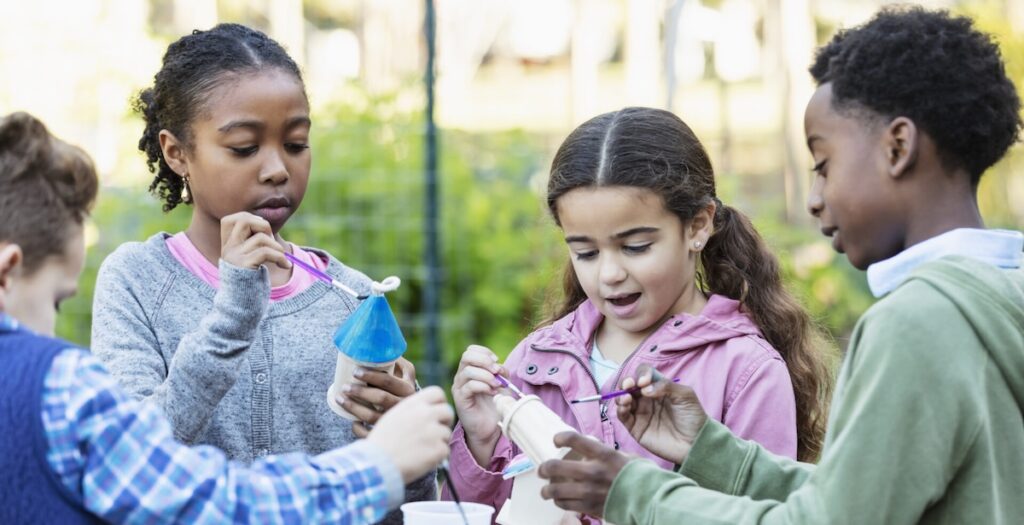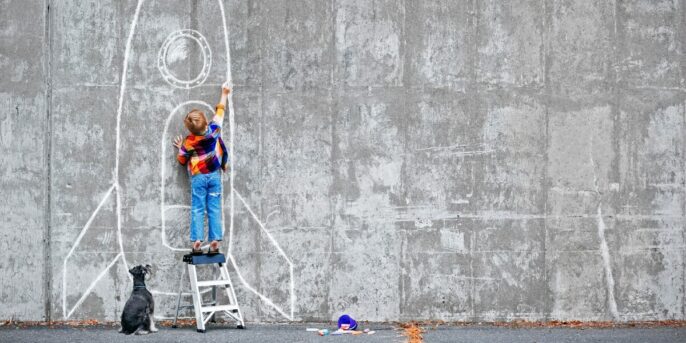“Their programs are interesting, but they’re so different from us.” A site leader heard this mumbled under their team member’s breath after visiting public and charter schools, microschools, and a camp in their region.
Learner-centered education asserts that learning can happen anywhere and with anyone. This philosophy is usually applied to the domain of childrens’ learning. Yet, when we stretch it to adult learning, an irony emerges: so often in education, we confine our openness to learn from people and places that mirror our own.
Sometimes I wonder if we create too many divisions in education, limiting who we allow ourselves to learn with and from, and limiting what we see as possible. Meanwhile, national chronic absenteeism hovers around 30%, 40% of high schoolers do not feel connected to school, educator burnout runs high, and the media’s saturated with stories about social and learning loss. These challenges call for a different approach in education where every young person feels known, finds value in what they are learning, and where this isn’t such an uphill battle for those making it happen.
What if we let the shared belief in our children and wellness of our society guide our learning, instead of focusing on our differences? What if we trusted that every person and every place holds lessons waiting for us to discover? As the needs shift for public education, we believe learner-centered education can be central to a systems change in our society. As we move towards this possibility, I am grateful that there is so much to learn from others that are already leading the way—people creating places and opportunities where young people want to be.
Who can we look to and where have we been learning from?
Since our beginning, Education Reimagined has been fortunate to discover, learn alongside, and connect people across the country who are building learner-centered sites and stronger communities. These environments physically and virtually connect people, places, and programs, going beyond the “four walls of school.” These environments also center community—both the values and feeling of belonging, and the neighborhoods they live in. Many of these environments hold their community’s past as an essential thread to the present, weaving together its complex history, cultures, resources, struggles, and a future filled with promise.
Over the past year, our team has journeyed the country far and wide, visiting and learning from these places. From rural towns to bustling urban cities, we explored public schools and public charters, independent and out-of-school settings. We saw environments who work with hundreds of young people and microschools who serve under 30 learners, located in liberal, conservative, and moderate ZIP codes—tight knit communities in the midst of revitalization and communities that some locals would say are still struggling to find their footing.
Reflecting on these site visits, it’s clear that although these environments look different, they feel similar and share a common thread: a culture of leading with deep care, shared curiosity, and commitment to children and communities able to thrive.
What if we let the shared belief in our children and wellness of our society guide our learning, instead of focusing on our differences? What if we trusted that every person and every place holds lessons waiting for us to discover?
Lindsy Ogawa
We can look to Charlotte, North Carolina. In a city with over 30% chronic absenteeism, the Charlotte community asked themselves: How can we leverage where young people choose to gather outside or instead of school?
Many Charlotte community leaders have embraced “third places,” including Ricky Singh, Founding leadership member of the Charlotte Lab School and current Executive Director of My Brother’s Keeper Charlotte-Mecklenburg, and organizations like Do Greater Charlotte, a community empowerment nonprofit led by William McNeeley. The idea of third places, developed by sociologist Ray Oldenburg, explores informal spaces where people go for social connection beyond “home” as our first place and “school or work” as our second—places like malls, barbershops, places of worship, and bookstores. Charlotte has been tapping into these third places around the city, building relationships with young people, learning about their interests, and pouring in resources and mentorship.
In one third place inside a cafe, several teens expressed interest in music. From that spark, community organizers secured funding to build recording studios, makerspaces, and purchase a van. Music professionals from the community stepped up to mentor young people, working with them on music production and to organize a live event. As part of the process, young people created beautiful flyers for the event but had to redo them when a mentor pointed out they forgot the location and time—a valuable learning moment! This third place also found passionate educators, burnt out from teaching in classrooms, but brilliant with teens. They knew how to listen deeply to learners and make their learning and skills visible, recognizing that this learning looks and feels different than a textbook. Over time, this initiative has benefited many, including local businesses, while keeping young people safe, connected to the community, and passionate about their learning.
We can look to the Rosebud Reservation in South Dakota: With nearly 50% of the population below the poverty line; where health, economic, and social adversities have been extreme; and the number of people who knew the Siċaŋġu Lak̇ota culture and language was waning, the Rosebud community asked themselves: How do we live today to create a healthy, just, abundant world for our grandchildren 175 years from now? How does our community want to teach our children?
These questions have led to Siċaŋġu Co, an economic development center focused on the community’s self-sufficiency and prosperity. This has blossomed into many intertwined initiatives with young learners and the community, including: Indigenous professors teaching courses, like ecology and education; the construction of beautiful, energy-efficient homes in a living community; initiatives for regenerative agriculture, growing food systems, and health and well-being; and, of course, Wak̇aŋyeja Ki Ṫokeyaḣc̄i, Siċaŋġu’s immersive school grounded in language and culture revitalization—where learning is connected to who each learner is as an individual, the influence their ancestors made spanning generations, and a future path they know is theirs to continue shaping.
While visiting, we heard from children who were excited for a buffalo harvest. They, along with the community, planned to use every part of the buffalo—showing us a pendant made from buffalo bone and sharing that they would process the meat to provide lunches for the broader community. This led to reflections about how they, the land, and the buffalo are intertwined. Across ages, you heard origin stories and about trips to sacred places that children, families, and educators visited together, and what they learn from each other, everything from recipes to video games. These educators are energized by the community they are part of creating. One smiled and said, “This is the best. I wouldn’t want to be anywhere else.”
We can look to Colorado Springs: In a neighborhood where intense focus on academic achievement has led to many young people struggling with mental health, community leaders asked themselves: How would we design school if it wasn’t at the center of learners’ lives?
Nathan Gorsch and Lindsay Keller, founders of Village High School, looked around and noticed that most of their learners were juggling jobs, competitive sports, academics, and their home lives. They were needing to prioritize one over the others. Village High School blends technology and in-person learning to offer a flexible and supportive learning environment. While hybrid learning is not new, they found a way to waive seat-time requirements by operating under a state-wide online school license and still have a physical campus. Learners only need to be on campus for part of the day, certain days of the week. Traveling for sports and working? No problem. There’s the option to be off-campus for weeks at a time, if needed, and advisors still check-in.
While visiting the campus, we noticed learners called the building their meeting place. They go to socialize and meet with advisors to review goals or discuss their week. Others leave campus, go on field trips for new experiences, and take project-based workshops or internships in areas like entrepreneurship, motorsports, woodworking, and the psychology of relationships. Around noon, some learners had their legs kicked up and were laughing with friends. One was packing up to head to his job. Another said he was checking-in with his advisor after traveling for hockey, something he does regularly. Parents said their children were happy here. Educators who were previously burnt out in their other settings also shared this was healing for them as well, emphasizing that here, they can focus on what matters to them—building relationships and being trusted to find and create opportunities to learn and share their interests with others.
How can we continue learning together?
I fully believe that within these places and beyond—and within each of us—lie gems still waiting to be uncovered. We can learn from anyone, at any time, and anywhere. These lessons are shaping and informing the landscape ahead.
Education Reimagined is there to support the field’s learning and collaboration, and mine for those gems—through communities of practice, publishing research and evidence, uncovering policy conditions to sustain this education, and amplifying the stories and promise of learner-centered education across K–12, workforce development, and related sectors.
As we look ahead, I am eager to continue learning from you and others in this field, asking questions like:
- What lessons and stories are you most excited to share about your learner-centered journey?
- What are the top challenges impacting your community or work that would make the biggest difference if they were no longer a barrier?
- What are important inquiries you or the field don’t yet have answers for that you’d want to investigate with others in the field?
- What is the evidence you’re already collecting about the impact of learner-centered education? What evidence would be most helpful, if you had it?
I am more certain than ever that this possibility cannot be achieved alone; it’s essential to join arms in service of a greater common good. Despite the daunting challenges ahead, I am humbled, inspired, and eager for us to work together towards our common goal: ensuring every single child, without exception, is able to thrive.




